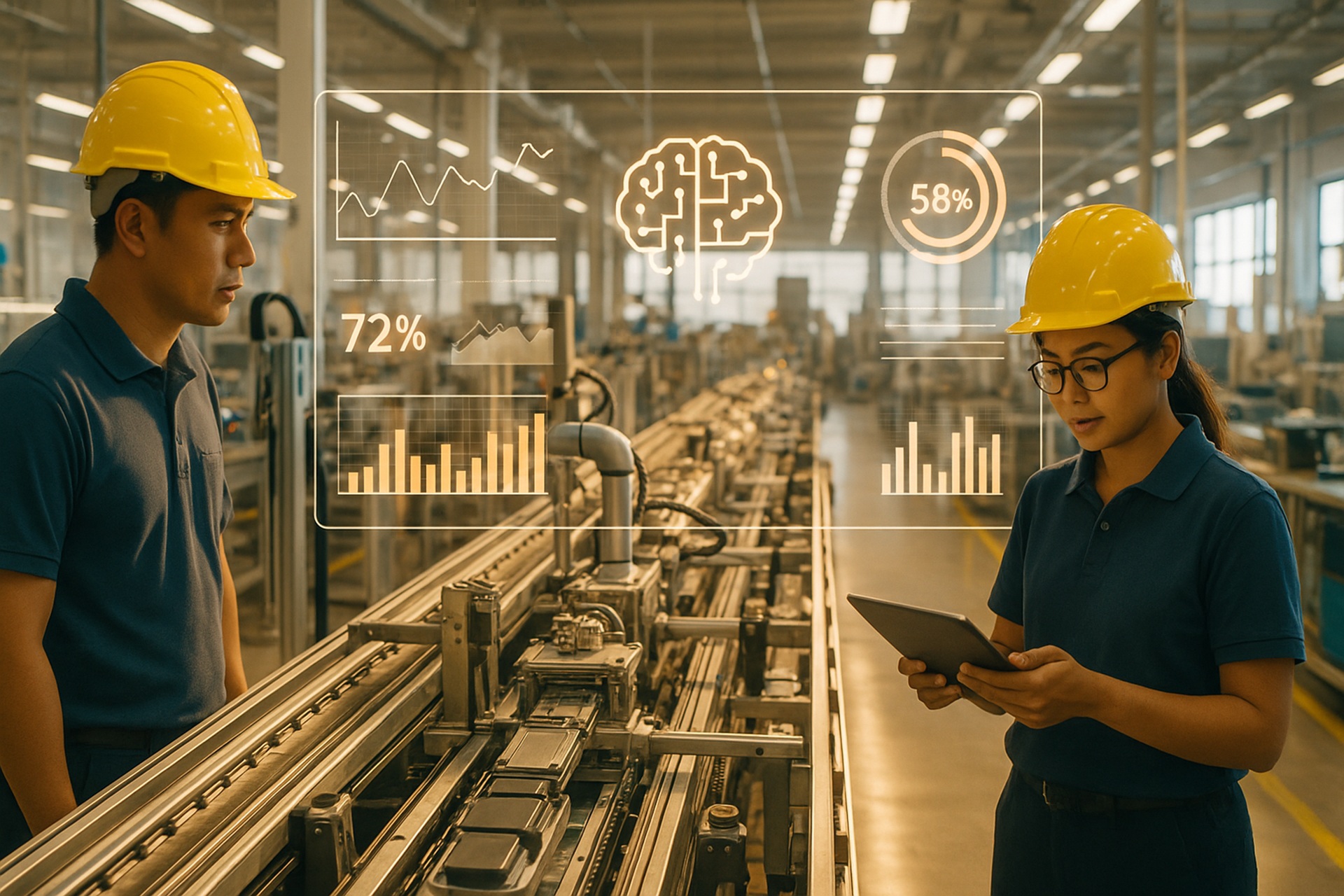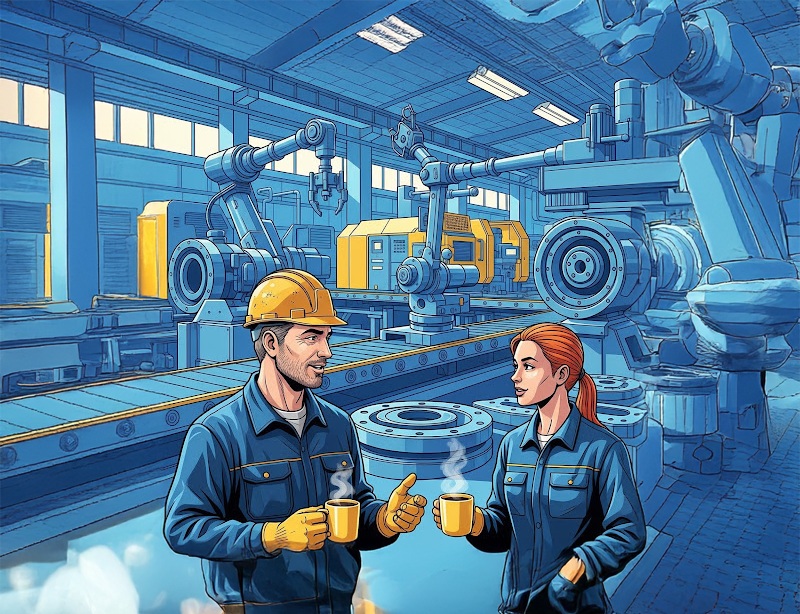In manufacturing, productivity has always been the heartbeat of competitiveness. Yet, across Malaysia, many factory owners are facing the same challenge, despite automation and better machinery, productivity isn’t improving as fast as it used to.
The reason is simple: traditional automation can only take you so far. The next leap doesn’t come from working harder or buying more machines, it comes from working smarter. That’s where Artificial Intelligence (AI) enters the picture.
1. The New Productivity Challenge
For decades, factories improved output through lean processes, automation, and continuous improvement programs. These methods worked well but they’re reaching their limits.
Today’s manufacturing environment is far more dynamic. Customer demand changes rapidly, supply chains are unpredictable, and even small production disruptions can cascade into costly delays.
Malaysia’s Industry4WRD policy, introduced by MITI, recognizes this gap. It encourages factories to move beyond automation toward intelligent manufacturing, where data, sensors, and AI collaborate to make better, faster decisions.
But what does that look like in practice?
2. From Reactive Operations to Intelligent Decision-Making
The biggest difference between traditional automation and AI-driven operations is adaptability.
Automated systems follow fixed rules, if A happens, then do B. AI systems, on the other hand, learn from patterns, adjust to changing conditions, and optimize in real time.
Imagine a production scheduler that doesn’t just assign jobs based on availability, but continuously updates priorities based on order urgency, machine health, and energy pricing.
Or a packaging line that detects inefficiencies on its own and adjusts speeds automatically to prevent bottlenecks.
That’s not the future, it’s happening now in smart factories across Malaysia.
3. Smarter Scheduling and Resource Optimization
In most factories, production schedules are still manually planned using Excel sheets or rule-based systems. The problem? Reality never follows the plan.
AI changes that by bringing predictive intelligence into the equation:
- It learns from past production data to forecast cycle times more accurately.
- It detects when a line is running slower and automatically reallocates jobs to available machines.
- It suggests the best sequencing to minimize idle time and setup changeovers.
For example, a metal fabrication plant in Johor used an AI-based scheduler integrated with its MES system. Within months, it reduced idle machine hours by 12% and increased total throughput without adding a single new machine.
When you scale that across multiple shifts and lines, the impact on profitability becomes substantial.
4. Real-Time Monitoring and Bottleneck Detection
Even the best production plan fails without real-time visibility.
AI bridges this gap by continuously monitoring sensor and equipment data to identify inefficiencies as they happen.
Let’s say a packaging line suddenly slows due to a minor sensor drift or material inconsistency.
Traditional systems might miss it until output numbers drop.
AI, however, detects the deviation immediately and alerts the operator, or even makes small adjustments automatically.
Over time, these small, data-driven interventions prevent hours of downtime and wasted effort.
According to MIDA, Malaysian factories lose thousands of productive hours each year to unplanned slowdowns. AI turns these hidden inefficiencies into measurable improvements.
5. Predictive Energy and Maintenance Efficiency
AI doesn’t just improve throughput, it also helps factories use energy and maintenance resources more wisely.
By analyzing equipment patterns, AI can:
- Predict when machines are likely to require maintenance.
- Optimize maintenance schedules around production cycles.
- Identify energy-intensive operations and suggest load balancing or off-peak adjustments.
For example, one F&B processor in Selangor used AI to analyze its utility data and found that compressors were running at high loads during non-peak hours. Adjusting their sequence reduced monthly energy costs by nearly 10%.
These are practical, measurable improvements, not abstract digital dreams.
6. Building a Smarter Factory: Start Small, Scale Smart
AI transformation doesn’t need to start with a massive investment. The key is to begin with one line, one problem, or one machine, validate the results and then expand.
Here’s how successful factories typically start:
- Identify a productivity pain point — a line that’s consistently delayed or underutilized.
- Collect the right data — machine utilization, downtime logs, energy use, and quality metrics.
- Run a small pilot — implement AI scheduling, anomaly detection, or predictive alerts.
- Measure results — track uptime, output, and energy efficiency.
- Scale across lines or sites — once the model is proven and the team is confident.
The best part? Malaysia’s SME Corp and MIDA offer grants under the Industry4WRD program to support AI adoption, making it easier for local factories to take that first step.
7. The Leadership Factor
Technology alone doesn’t boost productivity, people do.
The most successful AI implementations come from leaders who create the right environment:
- Encouraging experimentation instead of fear of failure
- Training teams to interpret AI insights
- Building trust between operators and intelligent systems
When leadership drives the mindset shift, AI becomes a strategic advantage rather than another IT project.
8. Conclusion: The Smarter Factory Starts Here
AI is no longer an experimental technology, it’s the next stage of operational excellence.
Factories that adopt AI for smarter scheduling, resource optimization, and predictive insights are already seeing 10–20% productivity improvements within their existing infrastructure.
The opportunity is clear: work smarter, not harder.
At Ocunapse, we help Malaysian manufacturers boost productivity through AI-driven process optimization, predictive insights, and smarter decision-making. If you’d like to explore how AI can fit into your factory, start small, scale fast, and measure real results get in touch with us.








